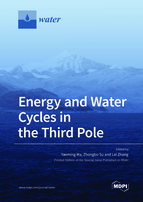Energy and Water Cycles in the Third Pole
A special issue of Water (ISSN 2073-4441). This special issue belongs to the section "Hydrology".
Deadline for manuscript submissions: closed (10 February 2022) | Viewed by 27157
Special Issue Editors
Interests: water cycle; evapotranspiration and evaporation; atmospheric boundary layer; satellite remote sensing application
Special Issues, Collections and Topics in MDPI journals
Interests: spatial hydrology; earth observation; water cycle and climate; land–atmosphere interaction; water resource management
Special Issues, Collections and Topics in MDPI journals
Interests: application of remote sensing; energy and water cycle; land-atmosphere interaction; hydrometorology; atmospheric boundary layer process
Special Issues, Collections and Topics in MDPI journals
Special Issue Information
Dear Colleagues,
As the most prominent and complicated terrain on the globe, the Tibetan Plateau (TP) is often called the “Roof of the World”, “Third Pole” or “Asian Water Tower”. The energy and water cycles in the Third Pole have great impacts on the atmospheric circulation, Asian monsoon system and global climate change. On the other hand, the TP and the surrounding higher elevation area are also experiencing evident and rapid environmental changes under the background of global warming. As the headwater area of major rivers in Asia, the TP’s environmental changes—such as glacial retreat, snow melting, lake expanding and permafrost degradation—pose potential long-term threats to water resources of the local and surrounding regions. To promote quantitative understanding of energy and water cycles of the TP, several field campaigns, including GAME/Tibet, CAMP/Tibet and TORP, have been carried out. A large amount of data have been collected to gain a better understanding of the atmospheric boundary layer structure, turbulent heat fluxes and their coupling with atmospheric circulation and hydrological processes. The focus of this Special Issue is to present recent advances in quantifying land–atmosphere interactions, the water cycle and its components, energy balance components, climate change and hydrological feedbacks by in-situ measurements, remote sensing or numerical modelling approaches in the “Third Pole” region.
Prof. Dr. Yaoming Ma
Prof. Dr. Zhongbo Su
Prof. Dr. Lei Zhong
Guest Editors
Manuscript Submission Information
Manuscripts should be submitted online at www.mdpi.com by registering and logging in to this website. Once you are registered, click here to go to the submission form. Manuscripts can be submitted until the deadline. All submissions that pass pre-check are peer-reviewed. Accepted papers will be published continuously in the journal (as soon as accepted) and will be listed together on the special issue website. Research articles, review articles as well as short communications are invited. For planned papers, a title and short abstract (about 100 words) can be sent to the Editorial Office for announcement on this website.
Submitted manuscripts should not have been published previously, nor be under consideration for publication elsewhere (except conference proceedings papers). All manuscripts are thoroughly refereed through a single-blind peer-review process. A guide for authors and other relevant information for submission of manuscripts is available on the Instructions for Authors page. Water is an international peer-reviewed open access semimonthly journal published by MDPI.
Please visit the Instructions for Authors page before submitting a manuscript. The Article Processing Charge (APC) for publication in this open access journal is 2600 CHF (Swiss Francs). Submitted papers should be well formatted and use good English. Authors may use MDPI's English editing service prior to publication or during author revisions.
Keywords
- water cycle
- evapotranspiration
- soil moisture
- precipitation
- land surface characteristic parameters
- radiation fluxes and land surface heat fluxes
- atmospheric boundary layer
- climate change
- remote sensing
- numerical modelling








